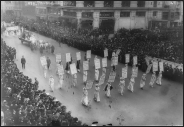

| The Library of Congress | |
 |
 |
 Parade, New York City, 1913 |
"Women, Their Rights and Nothing Less" The Suffrage Movement from 1840-1920 Eliza Hamrick and Donna Levene |
 Suffrage parade, New York City, May 6, 1912 |
"Principle not policy; Justice, not favors. Men, their rights, and nothing more; Women, their rights and nothing less."
The Revolution, edited by Susan B. Anthony (Hymowitz, 161)
Women obtained the right to vote nationwide in 1920. Before 1920, only criminals, the insane, Native Americans, and women were denied the vote. The modern woman's suffrage movement began in the 1840s with the Seneca Falls Convention. You've come a long way, baby. How did it happen and why?
Objectives |
After completing this unit, students will be able to:
|
Time Required |
Two weeks |
Recommended Grade Level |
Grades 9-12 |
Curriculum Fit |
U. S. history, American studies, state history, women's studies, politics |
Standards |
McREL 4th Edition Standards & Benchmarks Historical Understanding Language Arts US History |
Resources Used |
American Memory Collections:
Print Sources: Evans, Sara. Born for Liberty. New York: The Free Press, 1989. Hymowitz, Carol and Michaele Weissman. A History of Women in America.New York: Bantam Books, 1978. Ward, Geoffrey C. Not for Ourselves Alone; the Story of Elizabeth Cady Stanton and Susan B. Anthony, an Illustrated History. New York: Knopf, 1999. |
Lesson One: Analyzing Primary SourcesAfter discussing the definition and value of primary sources in analyzing an historical time period, students, divided into groups by time period, analyze sources using the Material Culture Analysis Guide to determine a woman's role in society.
Lesson Two: Changing Methods and Reforms of the Suffrage Movement from 1840-1920.Having determined the perceptions of women's roles in each of the three time periods, students analyze primary sources that outline the methods used and reforms demanded by the woman's suffrage movement in each time period. Students then put the information into the Time Period Analysis Chart. Using the timeline, students also determine what historical events affected the progress of the movement.
Lesson Three: Timeline and Reflection on Woman's SuffrageUsing the suffrage timeline, students will determine the major events and participants during each period of the suffrage movement and search the American Memory collections for sources to compile a Primary Sources Timeline. The culminating activity is a reflection paper by each individual summarizing the progression of the movement.
| The Library of Congress | American Memory | Contact us |
| Last updated 09/26/2002 |